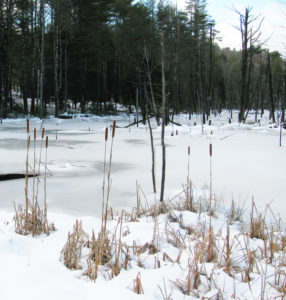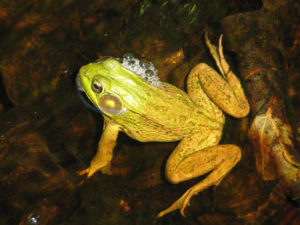(Phenology Happenings by Diane De Luca)
The Deering Wildlife Sanctuary is rich in wetlands: ponds, marshes, wet meadows, forested swamps. Winding streams connect many of these water bodies across the sanctuary. During several months of the year these wetlands are alive with sound, movement, and color. January cold brings a frozen landscape, quiet and subtle. It also allows exploration of areas that are not easily accessed when the water is open, as in treks to look more closely at the leatherleaf mats that stretch across the middle of Black Fox Pond, or the opportunity to clean out and examine the contents of the many wood duck boxes. The frozen egg fragments are reminders of these colorful ducks that glide among the fallen logs in spring.

Although the wood ducks can move to open water, many of the creatures that live in these wetlands are still here, under the ice. What are they doing to survive? As I gaze at Gray Tree Frog Pond covered in snow and ice, I think of the painted turtles that are so evident atop the partly submerged logs and protruding rocks as soon as the ice melts. A cold-blooded reptile, the painted turtle regulates temperature through its environment. During the colder months they hibernate underwater, buried in the mud to protect themselves from freezing. The cold water lowers their metabolism and need for oxygen. Instead of breathing through lungs, they must now extract oxygen from the pond water moving across exposed body membranes. An additional adaptation allows the painted turtle to use the calcium in their shells to balance the acidity that results from low oxygen. Warm weather and ice breakup will eventually bring the painted turtle out of hibernation so they can warm themselves by basking in the spring sun.

Overwintering frogs paint another story of life under the ice. Green frogs are a common aquatic frog whose loud banjo-string call reverberates across the Deering wetlands during the breeding season. They are often seen with their heads just above the surface of the water within close proximity of the shoreline. Green frogs, like the painted turtle, are cold-blooded and take on the temperature of their environment. Unlike the painted turtle, they do not bury themselves but spend most of the winter lying on top of the mud. They do not have the advantage of a shell and must remain in the oxygen rich water. They can, however, partially freeze and survive with up to 70% of the fluid in their body frozen. The cold prompts changes in their physiology and a high concentration of glucose is produced in the vital organs and prevents them from freezing. A natural antifreeze!
There are many more stories to be told of the life under the ice. A reminder that there is still much activity in the quiet of winter landscapes.
